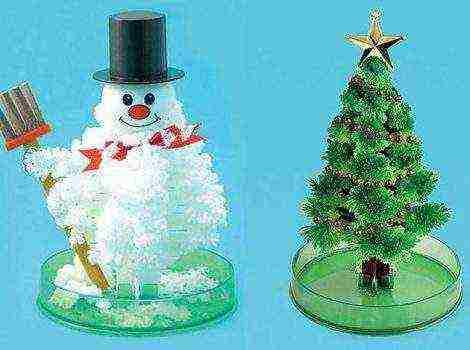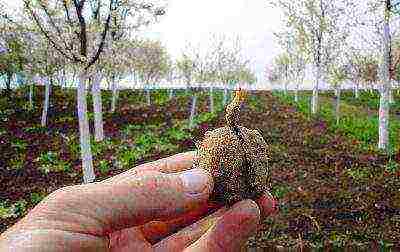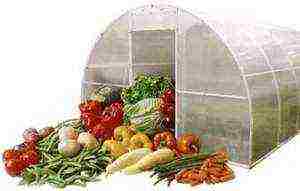Content
- 1 How to prepare gladioli for planting
- 2 Growing conditions and choice of planting site
- 3 Preparing the soil for planting gladioli
- 4 Inspection and preparation of gladiolus bulbs before planting
- 5 Planting gladioli in open ground
- 6 Care of gladioli after disembarkation in open ground
- 7 When to dig up gladioli
- 8 Preparing the bulbs for storage
- 9 Diseases and pests
- 10 Gladiolus varieties with photos and descriptions Colors of gladioli of Russian selection
- 11 Where is the best place to plant gladioli?
- 12 How to water?
- 13 When to fertilize gladioli?
- 14 Preparing bulbs for wintering
- 15 Growing gladioli outdoors
- 16 The most difficult thing in caring for gladioli is feeding
- 17 Planting monitoring is the main guarantee of gladioli health
- 18 Garter or hilling
- 19 Pruning gladioli
The African and Asian continents are considered the birthplace of Gladiolus. You'd be surprised if you find out which flower is called a skewer .. that's right, it's a gladiolus! It is hard to believe that such a noble plant was once just a field weed. The cultivated plant "Gladiolus" appeared in the Middle Ages. Now there are up to 5,000 of its varieties and hybrids, bred specifically for various zones, including those with cool climatic conditions.
When to plant gladioli outdoors?
Gladioli should be planted in the ground when the soil temperature reaches + 10 ° C. This is the month of April-May (depending on the region).
How to prepare gladioli for planting
There are special rules for growing this garden crop. Therefore, some gardeners who do not like to tinker with something for a long time dislike this flower. Although if you follow all the nuances associated with storage, purchase, planting and care, you can get a very good harvest.
The choice of planting material
A gladiolus bulb for planting can be either grown by yourself or bought in specialized stores. When buying, first of all, you should pay attention to the condition of the corm. If it is large, flabby, and has wormholes, then this is not the planting material that will bring you pleasure over time and should not be purchased. This is an old onion. When buying, pay attention to small young "kids" who, not this year, but in the next 4 years, will delight you with lush flowering.
Only healthy planting material, without signs of any diseases, can be chosen for planting. In addition, it is necessary to clarify whether this gladiolus variety is zoned to the region of your residence or not. Otherwise, you can be left without flowers. This is especially true in the northern regions, where cultivation in open ground is associated with certain risks. And the flowering of Dutch bulbs is generally focused on a period of no more than 1 year.
Growing conditions and choice of planting site
To create the best conditions for plant growth, it is necessary to take into account that gladiolus does not like low-lying, with stagnant moisture, soils. Oversaturation with moisture contributes to rotting of the bulb. Slopes with hummocks will also be unacceptable. Only a flat, dry place, which will not only be well lit, but also protected from the wind, will be suitable for planting gladioli.But you can not also overdo it with this, since complete calm can contribute to the development of diseases of a fungal nature.
Semi-shady places are suitable for growing only early varieties of gladioli... If late flower varieties are planted in such a place, they will not bloom at all. And the reason will lie in the lack of lighting. It should also be borne in mind that this is a very thermophilic flower.
Before planting, remember what kind of crop was cultivated on this plot of land last season. If these were flowers from the genus of dahlias, marigolds or plants from the legume family, strawberries and tomatoes, then feel free to use this piece of land to grow gladioli. Be wary of the area where potatoes, carrots or cabbage grew last season, as well as all those plants that were fertilized with manure. But it is very important that every 2 years the gladiolus is transplanted to a new place.
Preparing the soil for planting gladioli

When to plant gladioli in open ground in spring Planting and care photo
For gladioli, soil structure is very important. Therefore, sandy loam or loamy soil is quite suitable for planting a plant. With a planned transplant of a flower (and this is every 2 years), you also need to change the soil.
- The optimal PH-environment for the soil is slightly acidic, it should be in the range from 6.5 to 6.8. Overly acidic soils negatively affect the flowering of the plant. The appearance of a disease such as fusarium (the fungal nature of which is manifested by yellowness on the leaves, root rot and thinning of the stem) is also associated with increased acidity of the soil.
- The alkaline nature of the soil will cause the leaves to turn yellow due to the slowed-down formation of chlorophyll. This is caused by the intake of an insufficient amount of iron from alkaline soils.
To prepare the ideal soil for the growth of gladioli, it is necessary to add sand to the clay soil, that is, dilute the clay with sand. After you have decided on a site for planting, dig it up. The soil in a drier region should be prepared in the fall by digging it 15 centimeters deeper than if you did this procedure in the spring. At the same time, apply dry fertilizers (potash and phosphorus). This approach will maximize the preservation of moisture and before planting the gladiolus, all that remains is to loosen the soil.
Inspection and preparation of gladiolus bulbs before planting
At the initial stage, all bulbs are thoroughly examined. The scales that cover the corms must be carefully peeled off so as not to damage the young shoots. In case of damage to the bulbs with scab or sclerotinia, it is necessary to remove the affected area (cut off) and burn the resulting cut with green paint. This operation is performed 1 month before planting. The prepared bulbs are simply left in a small tray, sprouted up in a warm place, so that they germinate a little.
- Before planting, the bulbs are subjected to antifungal treatment. They are placed in a solution of potassium permanganate for a couple of hours or in a solution of basezol for an hour.
- Biennial (so-called juvenile) bulbs with pronounced root tubercles, the diameter of which does not exceed 8 mm, are subjected to special processing. Having laid them in one layer, they are placed under diffused light.
- Immediately before planting, the onions are placed and kept in a solution of potassium permanganate for 9 hours.
- The planting material prepared in this way is transferred to peat pots, which help to avoid breaking the delicate root during transplantation. And also this is a very convenient container for transferring the plant to a cooler place, if you notice that the flower has begun to grow intensively ahead of time. This is especially true of early varieties of gladioli. If for one reason or another you have not stocked up on peat pots, then simple containers can be used.
Planting gladioli in open ground
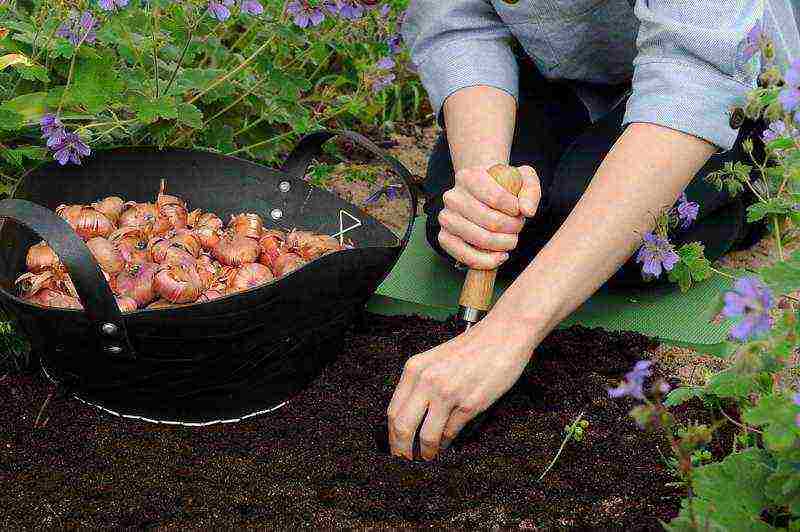
How to plant gladioli When to plant gladioli photo
How to plant gladiolus bulbs in spring? Some rules will help to avoid common mistakes and protect plants from diseases, increasing their vitality and directing them to abundant flowering.
To prevent gladioli from falling
- It is necessary to consider the structure of the land before planting in order to know how deep to plant gladioli... If clay prevails in the soil, then the depth during planting should be no more than 3 diameters of the bulb. If the bulb is deepened too deep, then the gladiolus simply will not bloom.
- In lighter, sandy soil, the depth of setting should be equal to four diameters of the bulb. In this case lack of bulb setting can cause the plant to slope to the ground and there will be a need to tie it up.
Anyway do not mix the bulbs of young and adult gladioli... The reason lies in one thing: large corms will take food from younger ones, depleting them. Therefore, it is better to plant the young growth separately.
Planting the bulbs is very simple: a groove of the appropriate size is dug, the bottom of which is sprinkled with sand or lined with sphagnum, all this is moistened and the bulbs are placed on this base. The distance between them should be at least 15 cm. Sphagnum will retain moisture and prevent fungi from developing. Everything is lightly covered with earth. As soon as the sprouts begin to germinate and appear on the surface of the soil, sprinkle them with earth again.
An interesting way of planting gladioli is shown in the video:
Care of gladioli after disembarkation in open ground
In order for the gladiolus to have a beautiful, even stem, the flowers in the arrow were presentable, it is necessary to make efforts for the next 2 months after planting in order to get the most positive result at the exit.
How to water
Gladiolus after planting should be watered every other day so that the peduncle is fully formed. This will require 8-10 liters of water per 1m². If dry weather is established, watering should be carried out at least 1 time a day in the evenings.
After that, it is advisable to loosen the earth in order to accumulate moisture inside and prevent it from quickly evaporating. In the case of the opposite, that is, when rainy weather is established, watering is either stopped completely, or limited to 2 times a week. In this case, the water must be well settled. It is not worth pouring it directly under the bulbs, as this contributes to their decay. It is necessary to pour in the aisle, then the soil near the roots is moistened. Gladiolus leaves tolerate spraying well.
Feeding gladioli
- When the sprouts reach 10 centimeters in length, it is necessary to fertilize the soil around the plant with humus. This is done in order to protect the soil from overheating and reduce the amount of moisture evaporated.
- During the formation of the first 3 leaves, fertilizing with fertilizers is necessary, which include mineral nitrogen. These fertilizers include urea and ammonium sulfate. It is introduced at the rate of 2 tablespoons per 1m² in order to form the green mass of the plant.
- Then they are fed twice with a mixture of complex potassium-phosphorus fertilizer: the first stage falls on the period of appearance of 5-6 leaves, the second - at the time of laying the buds. During potassium-phosphorus feeding, you can add a few peas of urea.
Four times during the entire growing season, during irrigation, organic fertilizers can also be applied under the plants.... It is better to use bird droppings for tincture (animal manure should be excluded) at the rate of: 1 bucket of droppings for 2 buckets of water. Organic fertilizer is infused for a decade, then it is diluted in a ratio of 1 to 10, where 1 share falls on the infusion and 10 on water. The quality of the flower depends on the regularity of feeding. Usually fertilizers are applied after watering, which is repeated after fertilization.
Simple disease prevention
For gladioli cultivated on sandy loam, it is good to carry out foliar feeding, the essence of which boils down to spraying the leaves with a special solution. For 1 liter of water, take 0.15 g of potassium permanganate or 0.15 g of boric acid or 0.2 g of Bordeaux mixture. This solution is used as a prophylactic agent against diseases and harmful insects.
Processing is carried out at least 3 times during the entire growing season: the first - during planting, the subsequent ones - during the appearance of the arrow and during the formation of buds. If you add soap to the solution and process the gladiolus leaves on both sides, then this will be a very useful procedure for him in the fight against spider mites.
Loosening the soil and weeding
The roots of absolutely all plants, including gladioli, love oxygen. Loosening will help provide access. To avoid the appearance of a crust on the soil surface, loosening should be carried out after watering. If you do not weed the flower bed, then the weeds will take nutrients from the soil, which will negatively affect the quality of the gladiolus flower. Therefore, weeding is simply necessary once a decade.
How to tie gladioli
The garter is necessary for those varieties of gladioli that reach more than 1.5 meters in length. To provide the stem with support, which over time begins to bend, you can attach a peg to each free-standing flower.
Many gardeners use a different method: they stretch the wire along the row with gladioli and
each flower is neatly tied to it. At the same time, the stems are spud to give them even more stability.
How to cut a flower correctly
In order not to damage the plant, the bulb of which will remain in the ground for some time, and to ensure that the stem is cut worthy of a bouquet, the following rules must be observed: leave a part of the stem with 4 leaves above the ground so that the bulb does not deteriorate. You can cut a flower only when the bottom 3 flowers are completely dissolved. Ideal varieties of gladioli are those whose ability to dissolve up to 10 buds at once is the norm. Cutting flowers is best done in the evening or early morning. The remaining peduncle stem is hidden deeper into the leaves.
When to dig up gladioli
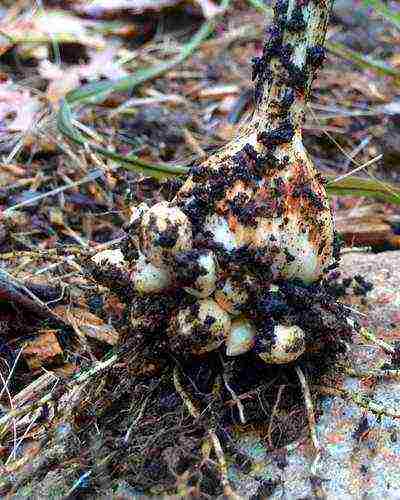
Baby gladiolus photo bulbs
To dig up the bulbs and store them until next year, you need to make sure they are ripe. Therefore, take into account the timing: the bulbs are dug up in September-October, in warm, dry weather. At least a month is required for the bulb, free from the peduncle, to accumulate the necessary juices in order to safely endure the winter. But it is better to give even more time, up to 45 days.
When digging up gladioli, remember that they give babies, and try not to damage them. The sides of the old corms can be literally covered with little "children", which we certainly want to grow and plant in the spring.
Preparing the bulbs for storage
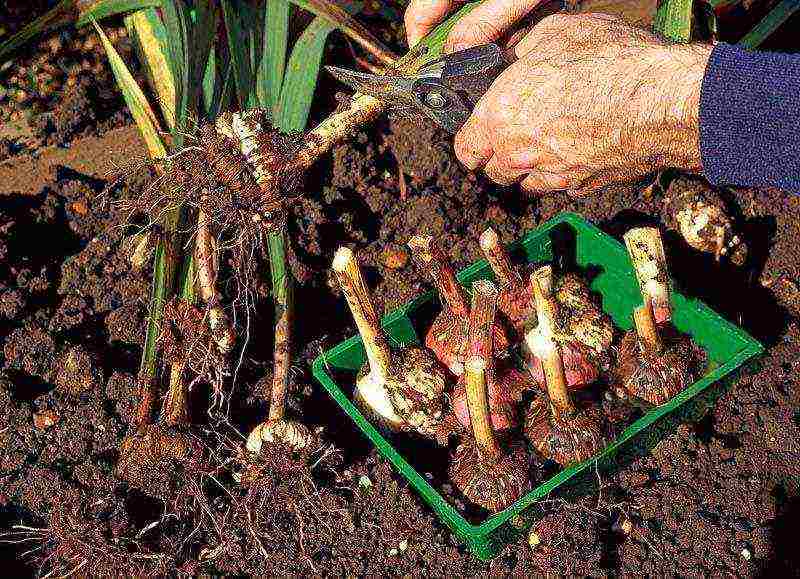
How to store gladioli in winter photo
- First, the bulbs are dug up only in dry weather. They start with early varieties of corms. When cutting off the stem, it is necessary to leave the stem 2-3 cm long from the beginning of the bulb.
- After shaking off the ground and pruning the roots, it is necessary to carefully examine the bulbs to exclude those specimens that may be carriers of diseases.
- The bulbs of each variety are separately washed under running water, dried and subsequently treated twice with an antifungal solution of foundationazole.
- Further drying is carried out in the sun, in a well-ventilated place for a month.
How to store gladiolus bulbs in winter
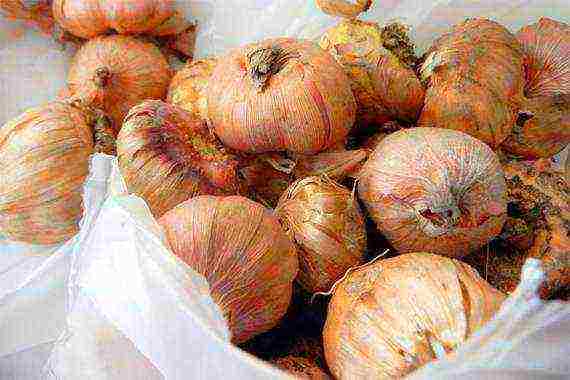
How to store gladiolus bulbs in winter photo
After drying, each onion is separated from each other (this applies to the old, new replacement and "babies"), wrapped in paper for storage and the variety is signed.
- All bulbs are folded into a cardboard box and stored closed to retain maximum moisture during wintering.
- You can store them on the bottom shelf of the refrigerator. Small "children", up to 1.5 cm in diameter, are kept in paper bags under the same conditions as their parents.
- During the rest period, and this is the first 1.5-2 months, there should be no problems with the bulbs at all. After this time, they begin to look after the gladioli bulbs in order to avoid early germination and to exclude the occurrence of diseases.
- Garlic cloves, which act as a natural air decontaminant, are added to the onion containers and placed in a well-ventilated, cool place.
Diseases and pests
Diseases in gladioli can occur both on their own due to the carelessness of the owner, and due to the spread of infection from other crops. Common diseases: botrytis, rust, septoria and fusarium. All of them are of a fungal nature, which they begin to fight against even during the treatment of the bulbs with foundation.
- The preparation "Horus" and "Falcon" is used at the stage before the flowering of the plant in the presence of 3 formed leaves.
- Against insect pests, such as bulb mites, thrips are used "Balazo", "Agrovertin", "Aktara", "Confidor-maxim". Only regular check-ups will help prevent serious illness. An attentive attitude to gladioli will surely be rewarded with its unique lush flowering.
Gladiolus varieties with photos and descriptions Colors of gladioli of Russian selection
Gladiolus is a very popular flower among those who are cut. It looks amazing in a bouquet, perfectly tolerates transportation and pleases the eye for a long time when standing in a vase. Due to the varietal variety, you can choose any shape and size, color shade and structure of the petal, flowering time and cultivation characteristics. For example:
Annushka variety can reach a height of more than 1.5 meters. The most delicate, with reinforced corrugation, flowers of an orange-pink unsaturated color can reach 13-15 cm in diameter. After planting, the first flower should be expected in 2.5 months.

Orange-yellow gladiolus Annushka photo of flowers
Arina variety - with corrugated, delicate in color, but dense in structure, raspberry-lilac flowers. Its distinctive feature is a rich, bright crimson spot in the middle of the flower.

Pink gladiolus Arina photo of flowers
Variety Eternal Call... It grows up to 140 cm and also belongs to large plants. The main color of the petals is pale pink, in the middle there is a red spot. The originality of the petals is given by their jagged structure along the edges, the structure embossed with veins and the density of the texture.
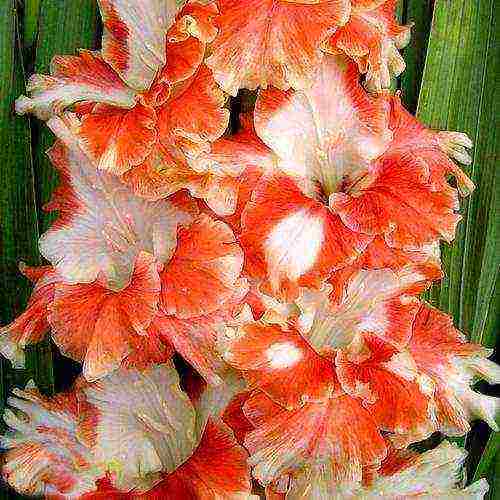
Orange and white gladiolus Eternal call of flowers photo
Blue butterfly variety speaks for itself: the most delicate blue color of a dense, large petal with a richer blue edging along the edge not only attracts attention, but also makes this gladiolus variety a leader in both exhibition exhibits and sales. It should be added that the flowering of a 145 centimeter plant begins 2-2.5 months after planting.

Gladioli of Russian selection, Blue butterfly variety, photo of flowers in the garden
Variety Sky and Stars... Very easy to grow and beautiful in bouquet. It has a large (up to 14 cm) corrugated blue-violet flower. Each petal of the flower is riddled with white rays and star-like spots, which gave the name to this variety.

White-purple gladiolus Sky and stars photo of flowers
Snegurochka variety possesses small, but strongly corrugated, bubbly white flowers. Looks amazing in a bouquet after cutting. It also blooms 80-85 days after planting.

White gladiolus Snow Maiden photo of flowers
Spartak variety refers to the mid-early, the height of its stem reaches 160 cm. Flowers - large brown-red with a smoky dark tint.At the bottom of each petal there is a white moire pattern. The neck has a silver coating.
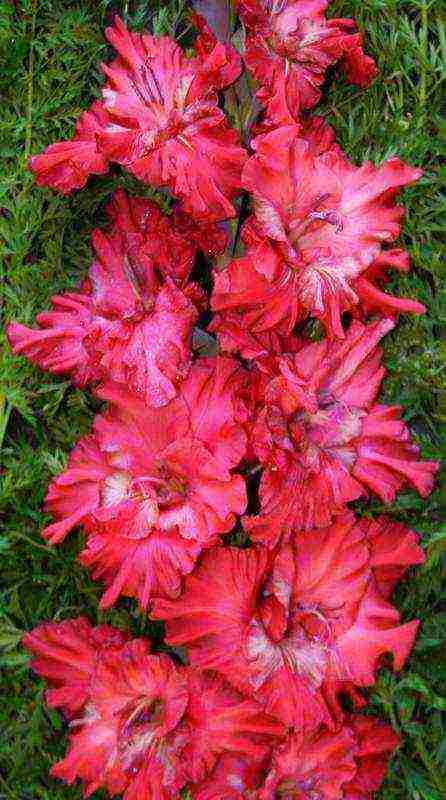
Red gladiolus spartacus photo of flowers
Variety Golden ten with bright yellow large inflorescences of double flowers amazes the imagination. A perfect decoration for any flower bed and luxurious cut flowers.

Yellow gladiolus Golden ten photo of flowers in the garden
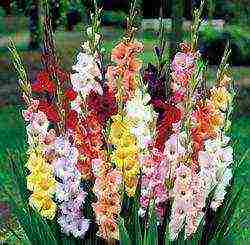 The lush gladiolus is perhaps the most amazing creature among all the flowering plants that can be found on the backyard. How to grow luxurious gladioli in the open field - to plant them and give them proper care - we will tell you in this article. We will also try to highlight their role in landscape design.
The lush gladiolus is perhaps the most amazing creature among all the flowering plants that can be found on the backyard. How to grow luxurious gladioli in the open field - to plant them and give them proper care - we will tell you in this article. We will also try to highlight their role in landscape design.
Description: varieties and varieties of gladiolus
Gladiolus (translated from Latin as "sword") belongs to the iris family and is a perennial corm plant. The leaves of this flower, with their outlines, are similar to pointed swords that shot up into the heavenly distance, and ancient Roman legends say that the corm of gladiolus contains a magical power that protects people from troubles and sorrows. Read also about other bulbs: tulips, hyacinths, daffodils.
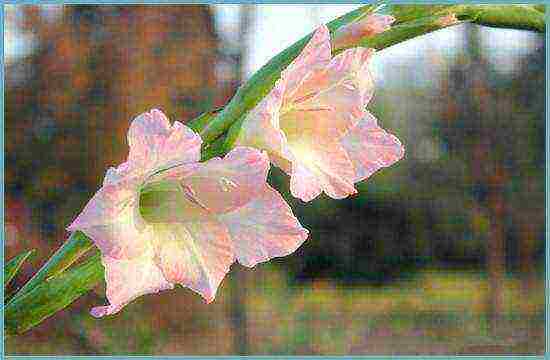
Gladiolus - a majestic and beautiful flower - is quite common in flower beds
The combination of originality and delicate colors, complemented by an unexpected corrugation pattern, makes gladiolus so organic that it is able to enchant the eyes of anyone who dares to look at this miracle.
Today, flower growers have about 170 species and subspecies, most of them come from Madagascar and South Africa. Varietal characteristics of this plant are combined into 2 groups:
- Decorative - everything here is determined by the length of the inflorescences and the number of flower buds in it; color, size and shape of the flower.
- Household - flowering period and height of the garden plant; sensitivity to weather and transportation; reproduction rate.
According to the gradation, each variety is assigned a three-digit code, where the first number indicates the size of the inflorescence, the second is the color, and the third is the tone.
The size of the blossoming flowers divides gladioli into the following categories:
- with miniature flowers;
- small-flowered;
- medium-flowered;
- large-flowered;
- gigantic.
Plants, abundantly strewn with small flowers (up to 6 cm) with a spectacular color, look great, gladioli with velvety flowers of large sizes (from 20 cm) are no less delightful.

Gladiolus grandiflorum
I would like to pay special attention to the description of the shape of the edges of the petals: it can be smooth, luxurious corrugated, fringed and folded. Nature has done a wonderful job on the color of flowers: fantastic transitions of shades and bright contrasts cannot but cause admiration. The entire color palette is present here, from pale shades to rich colors.
The flowering period divides gladioli into 7 groups, including early and very early specimens, mid-early and medium crops, mid-late and late plants, and finally, very late ones. In the middle lane, you can often find varieties with their inherent early, as well as medium flowering periods.

Gladiolus with bicolor flowers
Depending on the location of the flower buds in the inflorescence, the plants can be one-, two-row and zigzag. But the height divides the flowers into low, weak, medium and vigorous.
The abundance of species, as well as the natural beauty, delights gladioli. Often, breeders who worship this fragrant flower give years of their lives to develop new varieties with an even more luxurious color scheme and shape of inflorescences.
Planting a plant
To grow luxurious gladioli on your garden plot, you will have to be patient, read our recommendations and tips for planting, proper care and reproduction.
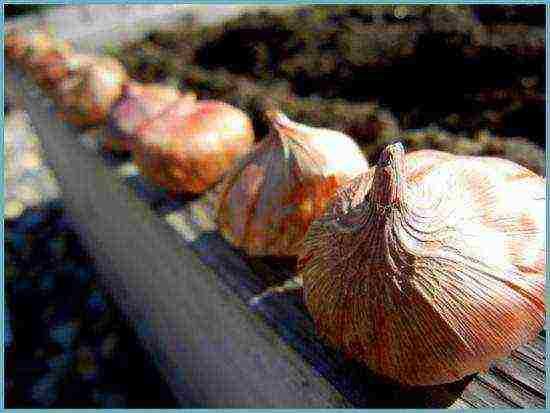
Gladiolus bulbs before planting
Growing gladioli, planting and care is a very laborious task, because it includes preparing corms for storage in winter, culling them, planting them in the soil in the spring, regular weeding, watering and loosening, feeding and treatment in case of diseases, as well as timely digging - all this cyclical nature of obligatory work will not frighten unless the true fans of this plant. However, the result will exceed all expectations: nature will more than make up for the time and effort spent on growing!
Advice! If you want to grow luxurious flowers, about which we can say that they are "like at an exhibition", then the varieties should be selected taking into account the characteristics of the soil and the climate of the area. It is better to buy a large baby, since its acclimatization will be easier.
Florists also recommend looking closely at young corms, while they should be outwardly healthy and have a high head.
You need to plant the baby annually. In this case, you will always have young corms at hand, with which you can replace the old ones at any time.
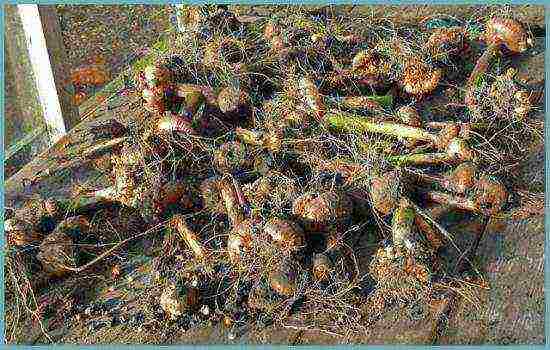
Gladiolus bulbs with formed "children"
Gladioli are known for their light and thermophilicity, so they are recommended to be planted in a protected area from the wind, where the sun's rays are frequent guests. Of course, partial shade is also quite suitable for growing flowers, but you should not expect early flowering. Ideally, the planting site should be on a hill, since a plant of the bulbous family can die from an excess of moisture.
Advice! It is better to choose neutral or slightly acidic soil for planting. It should include black soil, a small amount of clay or sand. Often, gardeners also resort to additional components - peat or compost, but only rotted.
When preparing corms for planting in the soil, they are cleaned of scales and visually viewed. Even if the bulb is healthy, it must be treated with a solution of potassium permanganate. It is recommended to plant gladioli in slightly warmed soil: its temperature at a depth of 15 cm should be + 8 ° C or higher.

Planting bulbs in prepared soil
Holes are made in the soil - depending on the size of the bulbs, the distance is from 5 to 15 cm. To speed up the process of plant emergence, gardeners cover the soil with a film.
Gladiolus care
This is not to say that cultivation of flowers is a difficult process, but nevertheless, one cannot do without observing certain points.
- After planting the plants, it is necessary to mulch using sawdust, humus and compost.
- Gladioli are recommended to water at least 5-6 times a week, taking into account weather conditions and at the rate of 10-15 liters of water per 1 m². So that the plant does not suffer from fungal infections, special grooves are made in the soil between the flower rows, into which water is poured.
- The growth and flowering of a crop is also influenced by the presence of weeds, on which slugs are often found, taking away nutrients from the roots of gladiolus. Therefore, special attention should be paid to the systematic weeding of flower rows and the removal of weeds.
- With the appearance of the second leaf, and until the very end of summer, you need to regularly feed the plant with mineral fertilizers. It is better to introduce them in small doses, combined with watering. Remember that feeding has a positive effect on the growth and quality of inflorescences, reduces the sensitivity of flowers to diseases.
- To cut the grown gladiolus, you need a pruner or a sharp knife, and the cut itself is made at an angle of 45 degrees. After the plant has bloomed, it is necessary to cut the stems on which the flowers bloomed almost to the root, leaving only a couple of leaves.

The minimum distance for planting plants is 15 cm, and the gardener determines the maximum distance himself, depending on the design of the flower bed
Advice! When watering gladioli, make sure that the water does not wet the leaves!
Fertilizing and feeding gladiolus
Throughout their growing season, gladioli need feeding:
- During the formation of the first 3-4 leaves, the plant is fed with nitrogen fertilizers. It can be mineral or organic (weak solution of chicken droppings) formulations that stimulate growth.
- With the appearance of 5-6 leaves, you can use fertilizers containing a complex of nitrogen, phosphorus and potassium substances. True, if the soil is sufficiently rich in itself, then nitrogen fertilizers can be excluded from this trio.
- At the stage of inflorescence formation, it is customary to use phosphorus-potassium dressings, which stimulate ripening and flowering.

Mineral dressings made according to the scheme are extremely necessary for the plant
In addition, once every 3 weeks, flower growers are advised to additionally use a diluted green fertilizer, and at the time of the appearance of buds and flowering - a suspension of wood ash.
Plant propagation
Usually, for the cultivation of bulbous plants, namely, gladiolus belongs to them, two methods are used: growing from a baby and dividing corms. In central Russia, corms can be obtained from a large and healthy baby in one season, which will be able to provide excellent flowering the next season. You just need to get rid of peduncles in time, if they appear.
Reproduction of new varieties, as well as varieties that give few children, occurs by dividing the bulb. It should be divided so that a kidney remains in each part.

Reproduction of gladiolus by dividing the bulb
But flower growers advise not to resort to seed reproduction of gladioli, explaining this by the fact that a culture grown in this way can lose its characteristic color and shape of flowers.
Diseases and pests
To protect your plants from disease, try to plant flowers in different locations every year. However, this recommendation is far from always applicable to small garden plots, which means that taking preventive measures is your main weapon against pests and diseases.

Disease-affected gladiolus bulbs
To disinfect the soil, you can use garlic cloves in the spring. To do this, it is crushed, laid out in the beds and dug up. Flowers can be planted after 2-3 days. Such a measure is effective against fungal diseases, but unfortunately, it is useless in relation to scab. To avoid this disease, gladioli are planted together with viola, which secretes phytoncides that suppress the appearance of scab pathogens.
Sawdust soaked in a nitrophene solution (1 spoon per 5 liters of liquid), in which the corms are then planted, also work very effectively. The number of plant treatments will depend on the condition of the soil and the quality of the planting material. While the plants are not blooming, they can be treated with the following preparations:
- fundozol solution (0.1%);
- copper oxychloride solution (0.3%);
- karbofos solution (0.2%);
- copper-soap preparation (100 g of green soap + 10 g of copper sulfate + 5 liters of water).
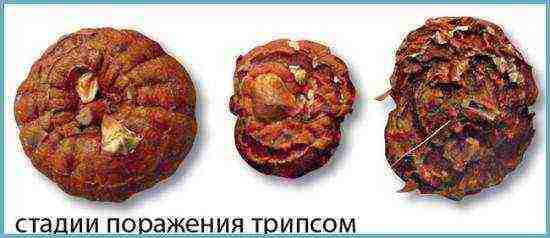
Diseases of gladiolus
It is allowed to spray with combined compounds, for example, copper oxychloride and karbofos. After the corms are dug out in the fall, they should be protected from fungi and bacteria with a 0.15% potassium permanganate solution or 0.2 fundozol composition. Reliably protects karbofos from rodents in the dosage recommended on the package.
Advice! Discovered specimens with visible traces of fungal diseases are subject to urgent rejection.
Gladioli: Combination with other plants
Needless to say, gladioli are quite capricious flowers both in terms of breeding and in terms of their participation in creating the design of the site. Too many gladioli will make the garden look like a breeding ground, and too few tall, slender plants look very scanty and lonely. It is no coincidence that landscape designers try to avoid the use of gladioli when arranging the territory.
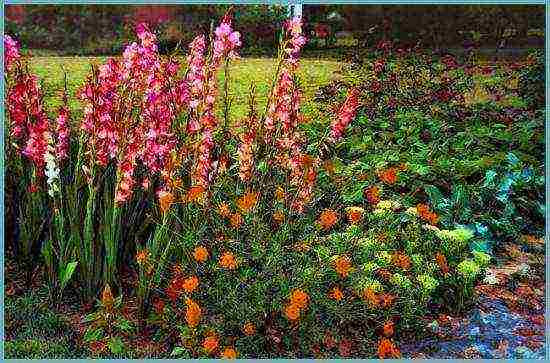
Gladioli can be planted in combination with other plants or mono-planting
However, experienced specialists, having contacted these majestic representatives of the flora, try to use several rules for placing gladioli in the garden and their combination with other flowers.
- The magnificence of the gladiolus is undeniable: this flower needs no accompaniment. But, since the riot of colors is only short-term, it should be surrounded by those flowers that will delight the eye before and after it blooms. These can be early tulips, delicate daffodils, which will be replaced by spectacular peonies, and after the flowering of gladioli ends, hydrangea will begin to bloom.
- Do not plant large dahlias and gladioli nearby, because they are eternal rivals in the colorfulness of flowers. Try to combine undersized (curb) dahlias as a companion.
- Since single bushes of gladioli do not look, they are usually planted in bouquets of several bulbs in a place. At the same time, one should organically select color solutions: varieties with contrasting colors and various shapes of petals look very impressive. Compositions of bright and saturated colors with delicate pastel shades are no less successful.
- It is not recommended to combine small-flowered varieties with large-flowered ones, otherwise the latter will cover all the beauty of small flowers.
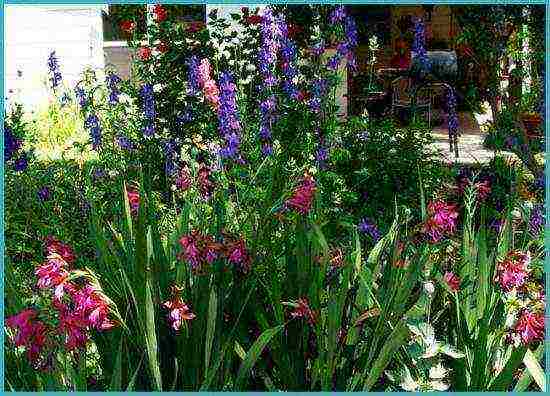
The flower beds look very interesting, which combine gladioli of different colors.
However, do not worry if at first you will not get beautiful flower arrangements! As you know, experience comes with time, so you will definitely develop your favorite planting schemes, which will become a real decoration of the summer garden.
Gladioli in landscape design
Florists of the world say the following about this beautifully flowering culture: "One gladiolus is like a delicate bouquet of delightful flowers, and the composition of gladioli creates a whole parade of flower pleasure." Every year the popularity of this colorful flower is growing in many countries, including ours.
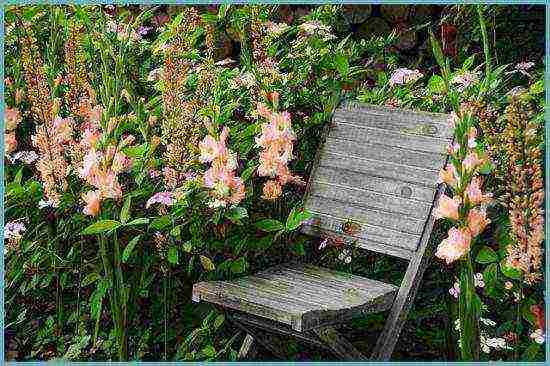
Gladioli perfectly emphasize decorative elements in the flower bed
A flower arrangement of gladioli of various shapes and colors, fragrant at the same time, will fill the backyard with an abundance of majestic plants on elongated and slender peduncles. And it is not at all surprising that talented landscape designers have resorted to creating picturesque oases from rainbow plants, thereby ennobling the garden plot.
Growing gladioli: video
Varieties of gladioli: photo



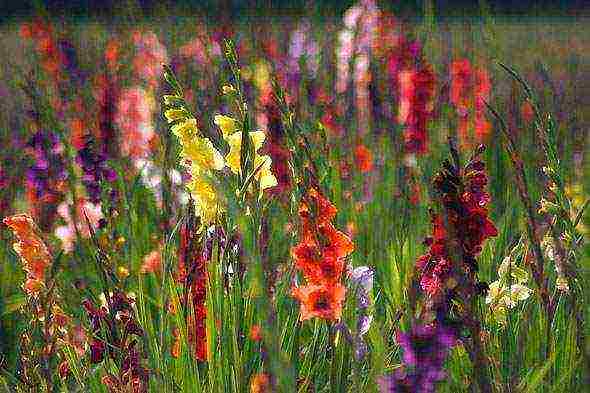

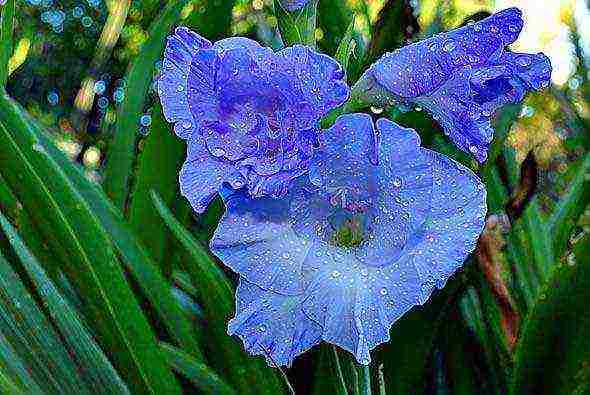
This year I ventured to plant gladioli at the dacha, although I prefer perennial flowers that winter in a flower bed. All bulbs have taken root successfully, despite my lack of such experience. Tell me what kind of care gladioli need to bloom?
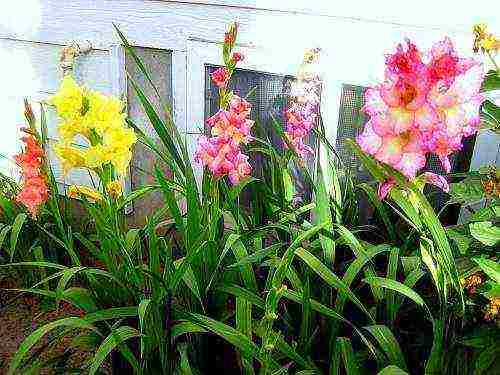 Gladioli are not difficult to grow. Of course, you will have to tinker a little with planting and digging the bulbs for the winter, but in general these are quite calm flowers that do not impose special requirements on care. In order for gladioli to grow well and bloom magnificently, it is necessary to carry out almost the same measures as when breeding other flowers, with slight differences regarding the wintering of bulbs.
Gladioli are not difficult to grow. Of course, you will have to tinker a little with planting and digging the bulbs for the winter, but in general these are quite calm flowers that do not impose special requirements on care. In order for gladioli to grow well and bloom magnificently, it is necessary to carry out almost the same measures as when breeding other flowers, with slight differences regarding the wintering of bulbs.
The basis for the care of gladioli are:
- the correct choice of landing site;
- regulated irrigation mode;
- periodic feeding.
Where is the best place to plant gladioli?
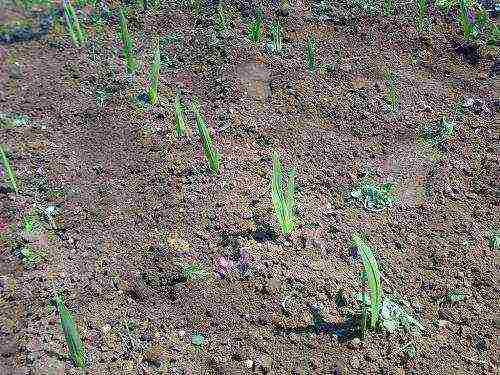
Gladioli love light and warmth, so for planting bulbs, choose a well-lit area that is not shaded or blown out.
When planted in the shade, the plants develop poorly, and flowering either occurs later or is absent altogether.
It should also be borne in mind that the flower does not tolerate the proximity of groundwater, therefore, the garden bed must be placed on a flat or sloping ground so that the water can drain.
In one place, gladioli can be grown for no more than two years.When planting large corms, it is better to plant them separately from small ones so that they do not oppress them.
How to water?
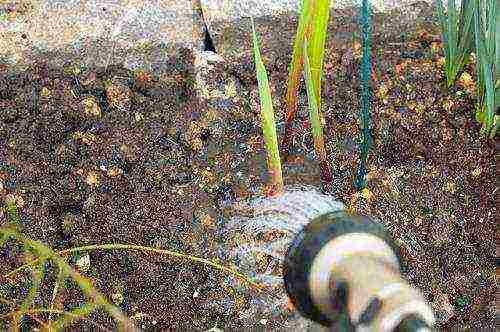
On hot summer days, during flowering, you need to water the flowers twice a week so that the flower stalks do not wilted and all the buds on them can open. The rest of the time, a single watering is enough (once every 7 days), but plentiful. It is important not to let water get on the leaves.
Every 10 days, gently loosen the soil around the bulbs, otherwise the resulting crust will not allow the roots to "breathe". To prevent the earth from drying out so quickly, you can mulch the plants with humus.
When to fertilize gladioli?

Over the summer, flowers must be fed at least three times:
- When 3 leaves sprout from the bulbs, apply nitrogen fertilizers (25 g of urea per 1 sq. M. Planting).
- At the phase of appearance of 6 leaves, add potassium-phosphorus preparations (15 g of superphosphate and 10 g of potassium sulfate and ammonium sulfate).
- After the formation of the peduncle, exclude nitrogen components by adding 15 g of potassium chloride and 30 g of superphosphate.
To accelerate flowering, you can spray gladioli on the leaf with a solution of copper sulfate (0.2 g of the drug per liter of water).
Preparing bulbs for wintering

In mid-September, when cover scales form on the bulbs, they must be dug up. Cut the leaves, peduncles and roots with pruning shears, and soak the bulbs themselves in the Fundazol solution for half an hour. Then rinse, rinse with a weak solution of potassium permanganate and put to dry for 2 weeks.
Store gladiolus bulbs in winter in cardboard boxes or fabric bags in a cool place (basement).
Video about growing gladioli: planting and care
Unlike most root-tuber and bulbous crops, which grow practically without leaving, gladioli cannot be called capricious. These charming representatives of the Iris family, which have long since changed the status of a hopelessly obsolete plant, conquer with long luxurious inflorescences and require constant care. But all the efforts made to provide the gladioli with the necessary watering and fertilizing are fully paid off by the beauty of flowering, relentless, colorful and unrivaled in the second half of the season.
Growing gladioli outdoors
Watering without delay
Gladioli produce strikingly large and tall inflorescences for corms of this size, but they do not form particularly powerful roots that can provide them with moisture from the deep layers of the soil. And that is why, unlike many other bulbous, gladioli need watering. They should be supportive, carried out weekly during periods of drought, or at least once every 10 days.
In order for gladioli to bloom colorfully and profusely, they need regular moistening of the soil to a depth of about 30-35 cm, on which the bulk of the roots of these plants is located. Surface irrigation for gladioli is absolutely not suitable, because it will not only lead to the rapid development of weeds, but also jeopardize the tissue of the root tubers themselves. For this plant, watering is considered optimal in the amount of 1-1.5 buckets of water for each square meter of soil under plantings.
Gladioli are watered not directly near the shoots and leaves, but along the furrows or aisles (it is better to lay them in advance, when planting, to a depth of about 3-5 cm especially for watering). During the procedure, in no case should water get on the leaves of the plant, and watering in the grooves will most effectively avoid the risk of spreading rot.
Regular loosening of the soil
Each irrigation procedure should be completed by loosening the soil, which will not allow the formation of a crust and will maintain the air permeability of the substrate, better distribution of moisture in the middle layer of the soil. After loosening, the plants are slightly spud with soil and be sure to re-lay the grooves for irrigation (to the same depth as when planting - from 3 to 5 cm).Loosening is carried out also after heavy rainfall, and with proper care - regularly, with a frequency of 1 time in 10 days. The only way to avoid time-consuming procedures is to create a mulch layer.
Take care of the mulch
Mulching in the early stages of plant development will protect gladioli from the vagaries of the weather, eliminate the need to loosen up to 3 times a month and effectively retain moisture in the soil, preventing weeds from spreading. The ideal strategy is to create a mulch layer of humus, peat, compost, pine needles, grass or straw immediately after the gladiolus sprouts reach a height of 10 cm.
Don't forget about weeding
Unlike watering, weeding for gladioli is carried out only 3 or 4 times during the summer, and more often even less often. If these plants include regular loosening or mulching in the care program, they act as a preventive measure against the spread of weeds and reduce the amount of traditional weeding to a minimum. The best strategy for gladioli is to remove young weeds in a timely manner, preventing them from developing and drowning out the growth of the bulbous ones themselves. Even if you do not have time for thorough care according to all the rules, you cannot constantly devote time to gladioli and engage in mulching and loosening, do not let the weeds heavily fill the areas under the flowers - they are amazingly easy to drown out, gladioli do not like competitors. Moreover, the spread of weeds will increase the risk of infection with pests and diseases, vulnerability to slugs and caterpillars, which will easily get to the succulent leaves of this plant.
The most difficult thing in caring for gladioli is feeding
Top dressing is the key to success in growing these plants. For the same reasons that gladioli cannot endure drought on their own for a long time and need systemic irrigation, they are also dependent on the constant replenishment of the level of nutrients in the soil. Unlike many other garden plants, there are no simplified feeding schemes for gladioli. The fertilization schedule for gladioli should correspond to the stages of development, because without feeding the plant it is difficult to move to the next stage and grow and develop normally.
The first feeding for gladioli they are introduced at the very beginning of their development, it is necessary for the active growth of shoots from the tuber, the formation of a high-quality leaf mass and the laying of peduncles. In the initial phase, gladioli most of all need nitrogen, but its amount should not be excessive, because an excess of this nutrient can lead to a delay in flowering. The greatest amount of nitrogen in gladioli is drawn from the soil at the stage of the appearance of the first true leaf, but it is better to feed it only at the stage of 2-3 leaves. Accordingly, with these requirements, the first top dressing is applied in the form of nitrogen fertilizers in a standard dose or complete mineral mixtures with a reduced potassium content (25-30 g of nitrogen fertilizers + 15-20 g of potassium + 30-40 g of superphosphate) are applied. The mineral mixture can be replaced with a combination of organic fertilizers, such as mullein or chicken manure, with the addition of half the dose of superphosphate and potassium permanganate. If you planted late varieties or carried out planting at the end of May-June, then it is better to postpone nitrogen fertilization until 4 leaves appear, and in unfavorable weather or an excess of organic matter in the soil, carry out the first fertilizing only in June.
When 5-6 leaves appear on the plant, the use of nitrogen in gladioli practically stops, and access to phosphorus is of greater importance for flowering and fruiting, especially before the beginning of budding and at the entire stage of preparation for flowering. Second feeding must also consist of three elements, but with a different ratio of elements.At this time, for gladioli, a standard dose of a phosphorus-potassium mixture or 10-20 g of nitrogen and potassium fertilizers and about 20 g of phosphate fertilizers are applied.
Before the start of flowering itself, the third period of development begins, during which gladioli most of all need potassium. Third feeding carried out exclusively with potassium-phosphorus mixtures during the budding period or at the beginning of the peduncle's movement, adding about 30-40 g of phosphate and 15-20 g of potassium fertilizers. Since mid-August, gladioli cannot be fed.
There is another feeding strategy, consisting of 6 procedures, which is often used when growing gladioli for cutting:
- After the appearance of the first true leaf, gladioli are fed with nitrogen fertilizers in the amount of 25-30 g with an addition of 20-25 g of potash per 1 m2 of soil.
- In the phase of 3-4 leaves, 10-20 g of nitrogen and potassium fertilizers and about 2 g of boric acid are applied.
- After the release of the sixth leaf, 15 g of nitrogen and 30 g of potash fertilizers are applied.
- During the appearance of the peduncle and the beginning of flowering, a full mineral fertilizer is used in the amount of 30 g.
- After the end of flowering, 15 g of phosphate and 30 g of potash fertilizers are applied.
- In late August or early September, gladioli are watered with a solution of 5 g of potassium permanganate per 10 liters of water.
On a note: If it is more convenient for you not to follow the development of plants and the phases that they pass, you can replace the standard fertilization scheme with regular watering in reduced doses, feeding in this case every 2-3 weeks and using a universal fertilizer for flowering crops when watering.
Fertilizers for gladioli should preferably be applied in liquid form; dry dressings are practically ineffective for them. If you have too much time, it is better to halve the standard dose of fertilizer and carry out two fertilizing with an interval of a week at each stage.
In addition to conventional dressings to accelerate flowering and improve decorative qualities, you can carry out up to 3 foliar dressings for all plantings of gladioli, in particular at the budding stage, using aqueous solutions of potassium permanganate, copper sulfate, boric acid or special mixtures of trace elements. Foliar dressing can be carried out only in the evenings or on cloudy days, using the smallest possible spraying method, trying to apply the mixture in such a way that fertilizers fall on both sides of the leaves.
Gladioli in tubs
Planting monitoring is the main guarantee of gladioli health
It's not just weeds that need to be monitored. Examine the plants themselves regularly, paying special attention to the leaves and noticing the slightest specks of yellowness. If there are signs of disease, stunted growth, yellowing and drying out, immediately get rid of diseased plants, even if you are not sure that they are affected by a fungal disease. Such specimens should be immediately dug up and burned, without waiting for the problem to spread to neighboring crops.
Garter or hilling
Most gladioli require additional support, because their peduncles are very long and heavy, prone to lodging. There are two support strategies for gladioli:
- Garter... For gladioli, they traditionally use not individual supports, but a twine or twine stretched in rows between the posts or around a group of plants, which will hold the peduncles.
- Hilling... Gladioli for the first time dug in soil to a height of about 10 cm at the stage of blooming 5 of a true leaf. Thanks to the hilling, the soil above the root system warms up better, the plant will feed more actively, and stable conditions will be created for active growth and the release of powerful peduncles that do not require additional support.
Pruning gladioli
Correct cutting of gladiolus inflorescences affects not only their durability in bouquets, but also the process of tuber formation.Cutting the peduncles of these plants should be carried out only in the evenings or early in the morning, when the plants do not lack moisture and do not suffer from heat.
You should not wait for the complete blooming of all flowers on the inflorescence and its greatest decorativeness: it is necessary to cut the peduncle when one lower flower is open or two lower buds are painted in colors characteristic of the variety and are preparing to open. Such inflorescences bloom completely in water, are perfectly transported and stand surprisingly long.
When cutting off the peduncles of gladioli, remember that you should not touch the leaves and remove them along with the inflorescences. Only those plants that have kept at least 4 full leaves for the bulb, and ideally 7-10 leaves, will be able to develop and grow normally, to mature for the next season. It is necessary to cut the inflorescences only with a sharp knife, at an angle, as low as possible above the leaf, but without asking it. In order to get a longer peduncle, you can not cut, but twist it, slightly cutting it from the flat side of the stem, then breaking and bending the shoot and, gently holding it just above the point of exit from the leaf, gently twisting it.
Pruning before storage is carried out only after digging. Even if you have already cut all the flower stalks, do not completely remove the greens, because they are very important for the ripening process of the bulbs.
